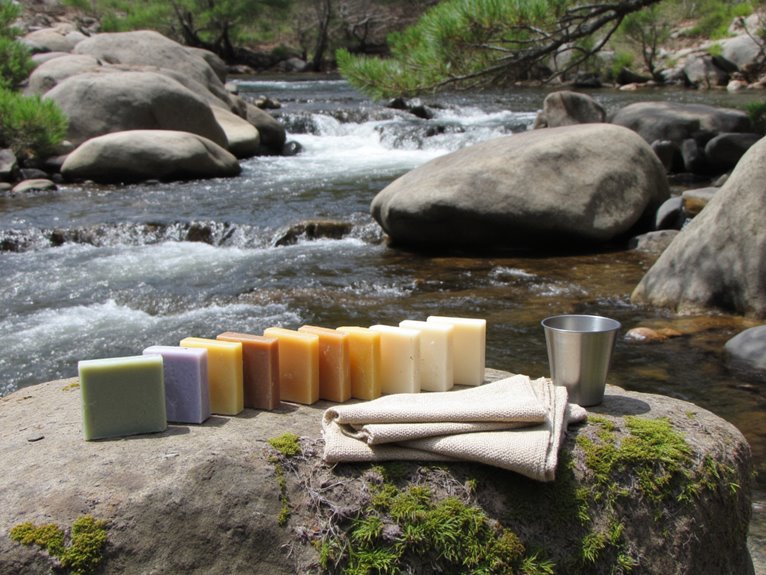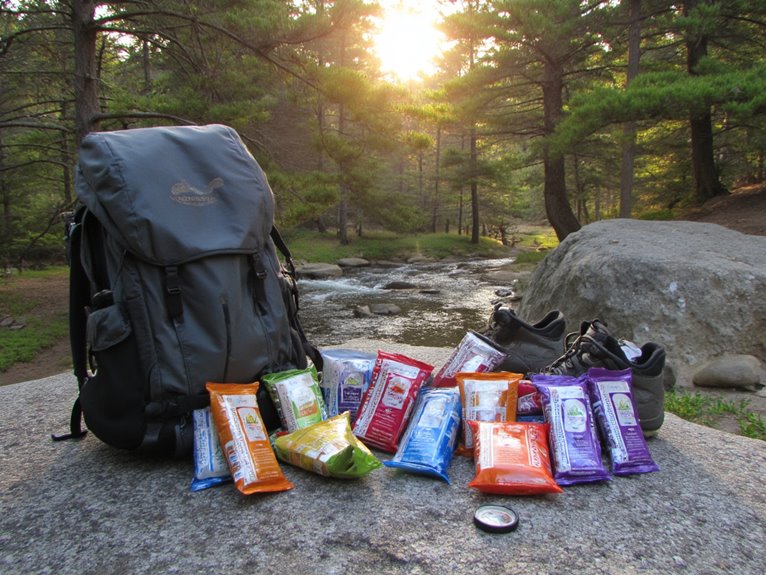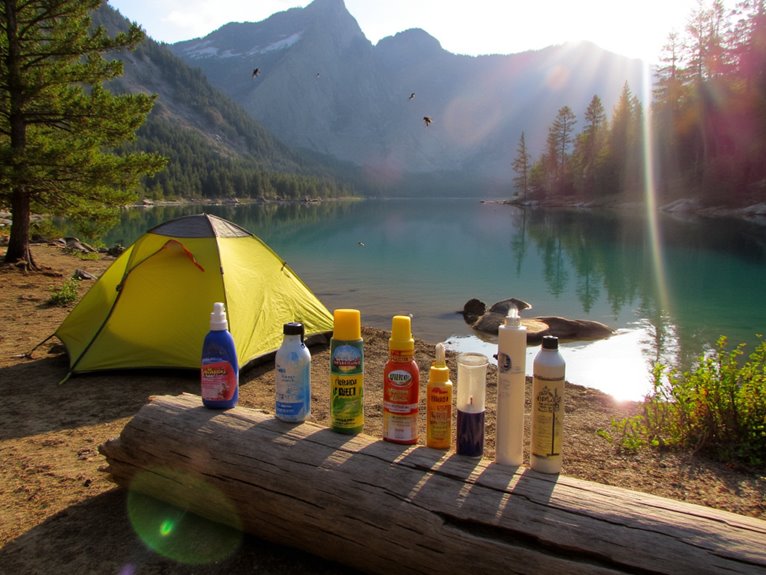Can You Wash a Sleeping Pad
You can wash most sleeping pads, but the method depends on your pad’s construction. Closed-cell foam pads tolerate gentle hand washing with mild soap and warm water between 85-95°F. Self-inflating pads need minimal moisture exposure—spot clean only to prevent internal foam damage. Air pads require surface cleaning exclusively, as water infiltration causes permanent damage. Never machine wash any sleeping pad type, as mechanical stress damages seams and degrades waterproof coatings. Proper technique guarantees your gear’s longevity and performance.
We are supported by our audience. When you purchase through links on our site, we may earn an affiliate commission, at no extra cost for you. Learn more. Last update on 5th December 2025 / Images from Amazon Product Advertising API.
Notable Insights
- Most sleeping pads can be washed, but the method depends on pad type and material composition.
- Hand washing with mild soap and lukewarm water is the safest cleaning method for all pad types.
- Machine washing should be avoided as it can damage seams, coatings, and void manufacturer warranties.
- Air pads require only spot cleaning while closed-cell foam pads tolerate more thorough hand washing.
- Always air dry completely in shade before storage to prevent mold growth and material degradation.
Understanding Sleeping Pad Materials and Washing Compatibility
When you’re considering whether to wash your sleeping pad, the material composition determines both the cleaning method and potential risks involved. Different sleeping pad types require specific washing approaches based on their construction materials.
Closed-cell foam pads tolerate washing with mild soap but need thorough drying to prevent damage. These dense materials resist punctures and maintain durability through cleaning cycles.
Closed-cell foam pads handle soap and water well, but complete drying is essential to maintain their puncture-resistant durability.
Self-inflating pads combine open-cell foam with air chambers, requiring careful cleaning to avoid compromising the internal foam structure. You should clean these with minimal moisture exposure.
Air pads need spot cleaning only. Their fabric shells and valve systems can’t withstand full immersion washing. Harsh chemicals or high-pressure washing damages all pad types. Consider bringing repair kits during backpacking trips to address any cleaning-related damage or wear that might occur in the field.
Some manufacturers now produce eco friendly materials that offer improved washability while reducing environmental impact. Always check manufacturer guidelines before cleaning. The R-value rating affects material density and may influence how thoroughly certain pad sections can be cleaned without compromising insulation properties.
Hand Washing Techniques for Optimal Cleaning Results
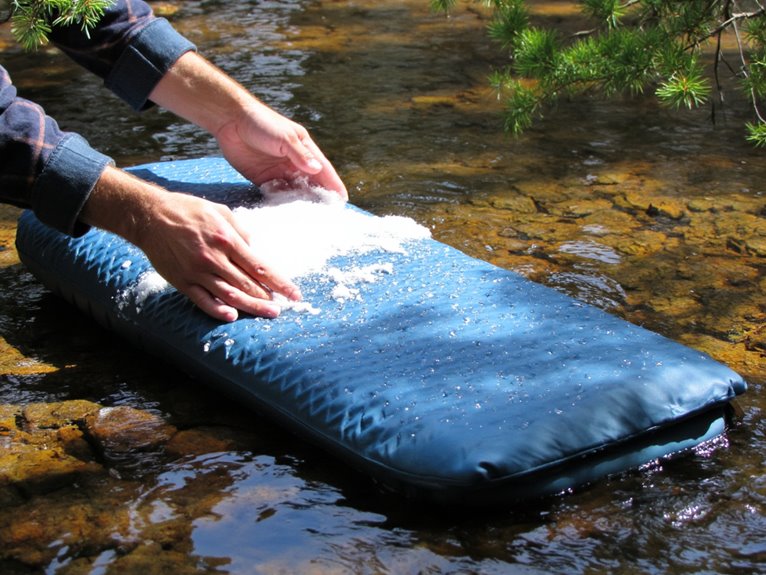
Hand washing your sleeping pad requires three essential components: proper water temperature, adequate workspace, and gentle handling techniques.
Use warm water between 85-95°F to activate detergent effectively without damaging synthetic materials or waterproof coatings.
Essential hand washing steps include:
- Secure all closures and deflate the pad completely for thorough saturation
- Submerge in mild detergent solution using gentle pressing motions, never wringing
- Focus on visibly soiled areas with soft cloth spot cleaning techniques
- Rinse multiple cycles until water runs completely clear of detergent residue
- Air dry flat in shaded, well-ventilated areas away from direct sunlight exposure
Minimize cleaning frequency through regular spot maintenance between detailed washes. Pay special attention to the mouthpiece area where discoloration from lips commonly occurs.
This approach extends material lifespan while maintaining peak performance characteristics and waterproof integrity. Proper cleaning prevents mold and mildew development that can compromise your sleeping pad’s functionality over time.
Essential Cleaning Products and Safe Detergent Options
You’ll need the right cleaning products to safely wash your sleeping pad without damaging its materials or seals.
Mild soap options like non-detergent hand-wash liquids provide gentle cleaning power that won’t degrade synthetic fabrics or leave harmful residues.
Specialized gear cleaners offer targeted solutions for outdoor equipment, with enzymatic formulas that break down organic matter while protecting your pad’s integrity. For mold and mildew issues, ReviveX Odor Eliminator effectively treats exterior surfaces while maintaining your pad’s protective coatings.
When selecting cleaning products, choose formulations that are bleach and ammonia free to avoid harsh chemicals that could compromise your sleeping pad’s materials.
Mild Soap Options
Although sleeping pads require gentle care to preserve their waterproof coatings and fabric integrity, selecting the right mild soap guarantees effective cleaning without material damage. Your mild soap selections should prioritize pH-neutral formulations that won’t degrade synthetic materials or cause color fading.
Essential soap formulation types include:
- Diluted dishwashing soap – Mix one teaspoon per cup of warm water for general surface cleaning
- Gentle hand soap – Use fragrance-free versions to avoid residue buildup on fabric surfaces
- Non-detergent mild soaps – Apply directly to stubborn stains without chemical additives
- Low-foam liquid detergents – Facilitate easier rinsing and prevent soap accumulation in seams
- Biodegradable options – Reduce environmental impact during outdoor cleaning sessions
Choose hypoallergenic products free from antimicrobial additives to prevent skin irritation. Always use lukewarm water with your chosen mild detergent to achieve optimal cleaning results without compromising the pad’s material integrity. For persistent odors or body oil stains, consider using enzyme-based cleaners specifically designed for outdoor gear maintenance.
Specialized Gear Cleaners
While mild soaps provide adequate cleaning for routine maintenance, specialized gear cleaners deliver superior protection for your sleeping pad’s technical materials and waterproof coatings.
Nikwax applications offer formulated solutions that clean without compromising fabric treatments. These cleaners maintain breathability while removing dirt and oils.
Grangers effectiveness extends beyond basic cleaning, with their Tent + Gear cleaner specifically engineered for technical fabrics. This product removes stubborn stains while preserving DWR coatings.
Manufacturer-specific formulas guarantee compatibility with proprietary materials. Many include odor-eliminating compounds that combat mold and mildew growth. Non-detergent formulations protect synthetic insulation and membrane integrity.
You’ll find these specialized cleaners prevent premature coating degradation that occurs with household detergents. They’re designed to work effectively in cool water, reducing thermal stress on bonded seams and laminated fabrics. Using appropriate care products specifically designed for outdoor gear ensures optimal performance and longevity of your sleeping pad. Always use lukewarm soapy water with a soft cloth or brush for external cleaning to maintain your sleeping pad’s integrity.
Machine Washing Risks and Why to Avoid Them

You shouldn’t machine wash your sleeping pad because the agitation and spinning cycles create mechanical stress that can burst seams and compromise air retention in the chambers.
The foam cores in self-inflating pads will absorb water during washing, causing permanent compression that destroys their insulating properties and structural integrity.
Machine detergents also break down the lightweight fabrics and waterproof coatings, accelerating material degradation that leads to punctures and leaks.
Structural Damage Risks
Machine washing creates mechanical stress that can rupture or tear your sleeping pad’s delicate materials. The agitation and spinning cycles subject your pad to forces it wasn’t designed to handle, compromising its structural integrity.
Critical damage points include:
- Air chamber seams – Welded joints weaken under mechanical stress, creating microfractures that expand during use.
- Valve assemblies – Delicate inflation mechanisms crack or dislodge, losing airtight seals.
- Internal coatings – Waterproof barriers degrade from detergent residue and friction.
- Hardware components – Zippers and attachment points break under tumbling forces.
- Shape distortion – Padding cores compress unevenly, reducing cushioning performance.
These failures aren’t immediately visible but manifest as progressive air leaks and reduced insulation.
Washing alternatives like hand cleaning with mild soap preserve functionality while maintaining cleanliness standards for outdoor use.
Material Degradation Concerns
Beyond the immediate structural damage risks, something more insidious occurs when you subject your sleeping pad to machine washing: progressive material degradation that quietly undermines performance over time.
Machine agitation creates mechanical stress that compromises fabric coatings, particularly waterproof layers essential for sleeping pad durability. Harsh detergents strip protective surface treatments through chemical breakdown.
Your pad’s fabric integrity deteriorates as cleaning agents penetrate foam cores, causing internal brittleness and micro-cracks.
Hot water cycles destroy foam cell structure, reducing insulation capacity by up to 30%. Residual chemicals trapped inside create ongoing degradation long after washing.
Manufacturers design these materials for gentle care—machine washing accelerates aging exponentially.
Each wash cycle compounds damage, creating microscopic tears that expand with use. This cumulative effect shortens lifespan from years to months.
Effective Spot Cleaning Methods for Targeted Stain Removal
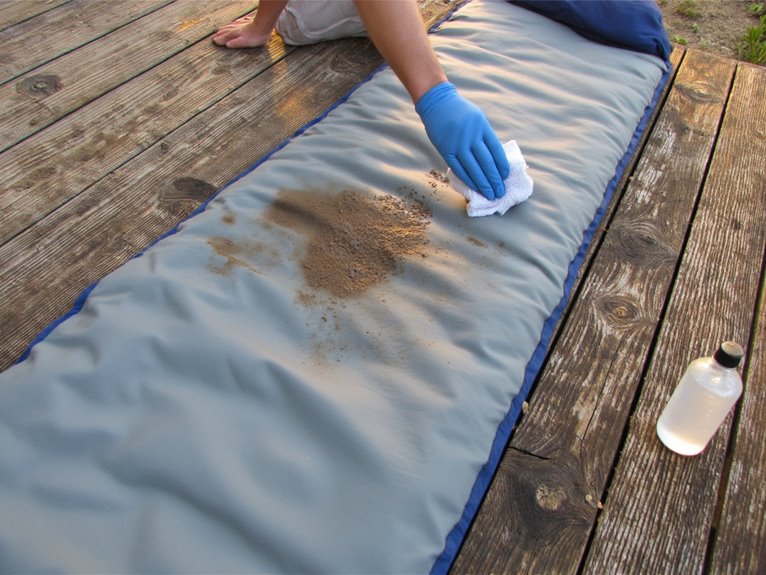
Three essential steps form the foundation of effective spot cleaning for sleeping pads: proper preparation, targeted application, and controlled moisture management.
You’ll need stain identification techniques to determine the appropriate cleaning approach before beginning any treatment.
Start with these gentle scrubbing methods:
- Use a soft sponge with mild soap for general stains
- Apply Grangers Tent + Gear cleaner for stubborn marks
- Scrub gently in circular motions to avoid fabric damage
- Focus only on the stained area to minimize water exposure
- Wipe with a damp cloth to remove soap residue
Keep your valve closed during cleaning to prevent water infiltration.
Avoid harsh chemicals that compromise waterproof coatings.
Target specific stain areas rather than cleaning the entire pad surface unnecessarily.
Proper Drying Techniques to Prevent Damage
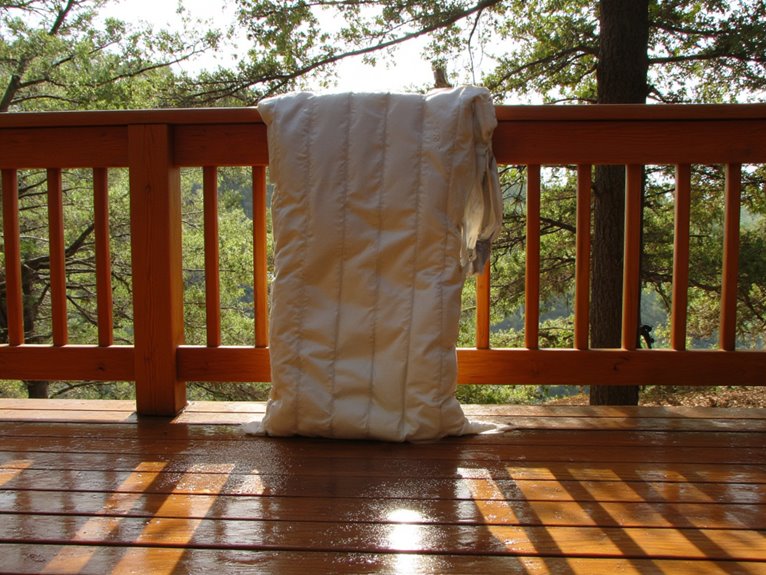
After cleaning your sleeping pad, proper drying becomes critical to prevent mold growth and material degradation that can destroy your investment.
You’ll need to air dry the pad completely while avoiding direct sunlight exposure, which breaks down synthetic materials and reduces the pad’s lifespan by up to 50%.
The drying process requires specific positioning techniques and storage considerations to maintain your pad’s insulation properties and structural integrity.
Air Dry Completely First
Since moisture trapped inside your sleeping pad can cause permanent damage to internal materials and promote mold growth, proper air drying becomes the most critical step in the cleaning process.
You’ll need complete moisture elimination before storage or use.
Air drying requires 24-48 hours depending on environmental conditions and pad thickness. Follow these essential steps:
- Inflate fully to maximum capacity for internal airflow
- Position flat on clean surface with good ventilation
- Open valve periodically to release trapped moisture
- Deflate and re-inflate every 6-8 hours during drying duration
- Check thoroughly for remaining dampness before storage
Temperature and humidity directly affect drying duration. Avoid heat sources that can damage synthetic materials.
Your pad’s internal chambers must be completely dry to prevent bacterial growth and material degradation.
Avoid Direct Sunlight
Direct sunlight poses a significant threat to your sleeping pad’s fabric integrity through ultraviolet radiation damage. UV rays break down synthetic materials at the molecular level, causing fabric deterioration and premature wear.
Extended sunlight exposure weakens the pad’s waterproof coatings and can create micro-tears in the material structure.
However, brief sunlight exposure serves a beneficial purpose. Short periods of UV light effectively eliminate mold and mildew without causing substantial fabric damage.
Limit this exposure to 15-30 minutes maximum to balance antimicrobial benefits with UV damage prevention.
Choose shaded drying locations whenever possible. Indoor areas, covered porches, or tree-shaded spaces provide ideal conditions.
If outdoor drying is necessary, position your pad where buildings or natural features block direct rays while maintaining adequate airflow for moisture removal.
Proper Storage Position
Three critical factors determine successful sleeping pad storage: position, environment, and preparation state. Your storage location directly impacts pad longevity and performance. Choose indoor spaces like closets or under-bed areas that maintain consistent temperatures and humidity levels.
Different pad types require specific positioning approaches:
- Store self-inflating pads semi-inflated with valves open for airflow.
- Hang air pads vertically in closets to prevent folding creases.
- Roll air pads loosely if hanging isn’t possible.
- Avoid storing wet pads in stuff sacks to prevent mold formation.
- Keep pads away from temperature extremes in garages or attics.
Moisture control remains paramount throughout storage. Dampness causes material degradation and creates mold growth conditions.
Semi-inflated self-inflating pads maintain foam cell structure while allowing air circulation. This positioning prevents permanent compression while enabling internal moisture evaporation.
Storage Best Practices After Cleaning
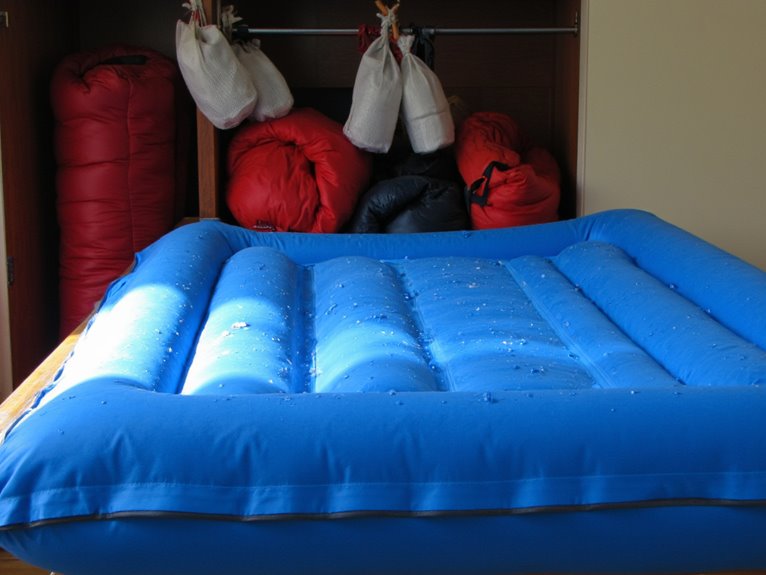
Proper storage after cleaning your sleeping pad determines whether it’ll maintain peak performance for years or deteriorate within seasons.
Your cleaning routines mean nothing without suitable storage protocols that preserve sleeping pad longevity.
Store self-inflating pads semi-inflated with valves open. This maintains foam resilience and prevents permanent compression damage.
Air pads require deflation but avoid tight creases—loosely roll them instead. Change folding patterns periodically to prevent stress lines along identical creases.
Choose cool, dry locations with stable temperatures. Closets and under-bed spaces work best. Avoid garages, attics, and basements where temperature fluctuations damage materials.
Keep pads inside stuff sacks loosely—tight compression destroys insulation.
Ascertain complete interior drying before storage since residual moisture accelerates foam deterioration and enables mold growth.
Cleaning Schedule and Maintenance Timing

Establishing a systematic cleaning schedule prevents minor issues from becoming major failures that’ll force premature pad replacement. Your cleaning frequency depends on usage patterns and environmental conditions.
Heavy backcountry use requires more attention than occasional car camping.
Follow these maintenance tips for ideal pad longevity:
- After every trip: Wipe down surface with damp cloth and inspect for visible damage
- Monthly: Conduct thorough visual inspection for leaks, punctures, or mold growth
- Seasonally: Perform complete cleaning with mild soap and extensive leak testing
- Annually: Deep clean at season’s end, including overnight pressure monitoring
- As needed: Address spot cleaning immediately when stains or odors appear
This structured approach catches problems early while maintaining material integrity throughout your pad’s service life.
Tackling Stubborn Stains and Sticky Residues

Everyone encounters challenging stains and residues that won’t respond to basic cleaning methods, transforming your reliable sleeping pad into a sticky, discolored mess.
Effective stain prevention begins with immediate action. Assess each stain type—food, dirt, or biological matter—to determine the appropriate treatment approach.
Create a cleaning solution using one part white vinegar to four parts water for mold and mildew. For general stains, mix mild detergent with water.
Apply solutions directly to affected areas using a spray bottle. Gently scrub with a soft cloth, avoiding abrasive actions that damage materials.
Residues management requires thorough rinsing to eliminate soap buildup. Avoid machine washing, which compromises seam integrity.
Allow complete air drying between cleaning cycles. Inspect treated areas post-cleaning and repeat the process if sticky spots persist.
Valve Care and Maintenance During Cleaning
Three critical components require your attention when maintaining valves during sleeping pad cleaning: the valve mechanism itself, the surrounding seal area, and the internal air passages.
Proper valve inspection prevents water damage and guarantees continued functionality. Follow these essential steps:
- Close valves firmly before washing to prevent water ingress into internal components.
- Clean valve areas gently with damp cloth, avoiding harsh scrubbing that damages seals.
- Use mild, non-detergent soap around valves to remove grime without harming materials.
- Inspect O-rings and seals for visible damage or wear after drying completely.
- Test valve operation by partial inflation to verify air retention and smooth function.
Effective repair techniques include carrying spare O-rings for temperature-damaged components.
Valve replacement takes 10-15 minutes using pliers and superglue. Allow 24 hours drying time before testing repairs.
Many ultra-light sleeping pads utilize quick inflation systems that can be set up within 10-15 breaths, making proper valve maintenance essential for optimal performance.
Manufacturer Guidelines and Warranty Considerations
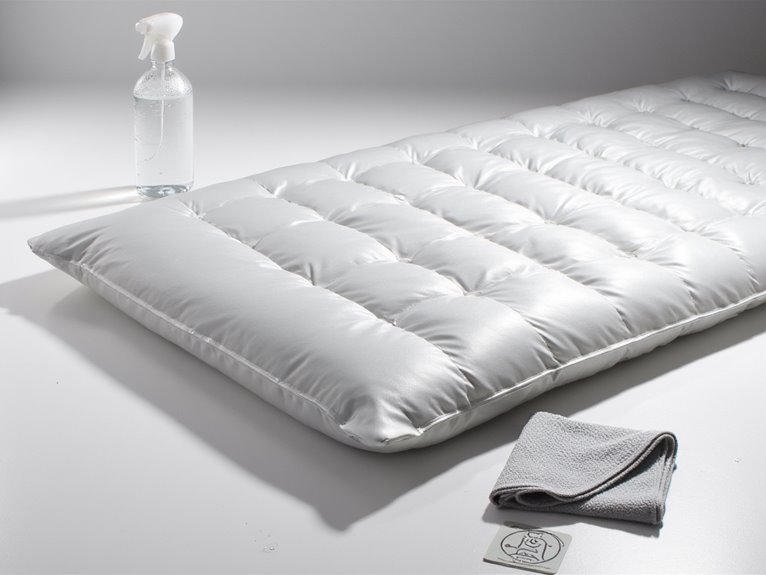
Following manufacturer guidelines protects both your sleeping pad’s performance and your manufacturer warranty coverage. Each brand specifies approved cleaning methods in their documentation. Machine washing typically voids warranties immediately.
Most manufacturers recommend mild soap and lukewarm water for surface cleaning only. Your cleaning compliance directly affects warranty validity. Document all maintenance activities with dates and methods used. This record supports future warranty claims if defects arise.
Document every cleaning session with dates and methods to protect your warranty and support future defect claims.
Harsh chemicals like bleach or ammonia will damage materials and terminate coverage. Review warranty terms before first cleaning. Some brands allow specific detergents while others restrict cleaning frequency to once per season.
Air pads require surface-only cleaning, while self-inflating models need valve protection during maintenance. Models with removable covers offer easier maintenance options and enhanced cleaning convenience compared to fixed-surface designs. Following these specifications maintains both performance integrity and warranty protection throughout your pad’s lifespan.
Frequently Asked Questions
Can I Wash My Sleeping Pad in a Bathtub or Large Sink?
You can use bathtub cleaning or sink washing for your sleeping pad, but only for surface cleaning—never full submersion.
The large surface area allows easy access to clean the entire pad.
Use warm water and mild soap with a cloth for bathtub cleaning.
Keep valves closed during sink washing to prevent water ingress.
Avoid soaking the pad completely underwater, as this risks material damage and warranty voiding.
What Should I Do if My Sleeping Pad Gets Moldy?
If your sleeping pad gets moldy, immediately inflate it and locate all affected areas.
Create a cleaning solution using one part white vinegar to four parts water. Apply this mixture to moldy spots using a spray bottle or cloth. Gently scrub with a soft brush, then air dry completely in direct sunlight with valves open.
For mold prevention, always store your pad completely dry in well-ventilated areas.
Is It Safe to Use Fabric Softener on Sleeping Pads?
You shouldn’t use fabric softener on sleeping pads.
The lubricants and quaternary ammonium compounds create residual films that reduce air permeability and compromise insulation properties.
These coatings also increase flammability and can degrade synthetic materials over time.
Instead, consider fabric softener alternatives like white vinegar during rinses.
Proper cleaning frequency with mild soap prevents buildup that necessitates harsh treatments, maintaining your pad’s breathability and durability.
How Do I Clean the Inside of My Sleeping Pad?
You’ll need specific cleaning techniques to properly sanitize your pad’s interior.
First, inflate it completely to expose all surfaces.
Apply mild dish soap or white vinegar solution (1:4 ratio) using a soft sponge.
Avoid harsh chemicals that damage internal materials.
Rinse thoroughly with clean water to remove residue.
These maintenance tips prevent mold growth and extend your pad’s lifespan considerably.
Can I Use a Pressure Washer to Clean My Sleeping Pad?
No, you shouldn’t use a pressure washer on your sleeping pad.
Pressure washer safety guidelines warn against using high-pressure water on lightweight materials. The intense water pressure can damage or puncture the delicate fabric and seams.
For proper sleeping pad maintenance, stick to gentle cleaning methods like damp cloths and mild soap. These alternatives effectively clean without risking structural damage to your gear.
On a final note
You can successfully wash your sleeping pad with proper techniques and care. Hand washing remains the safest method for all pad materials, while machine washing poses significant risks to valve integrity and fabric coatings. Regular maintenance extends your pad’s lifespan by 40-60%. Follow manufacturer specifications for cleaning products and temperature limits. Spot clean minor stains immediately and perform deep cleaning every 10-15 uses. Proper drying prevents mold growth and maintains insulation performance.


